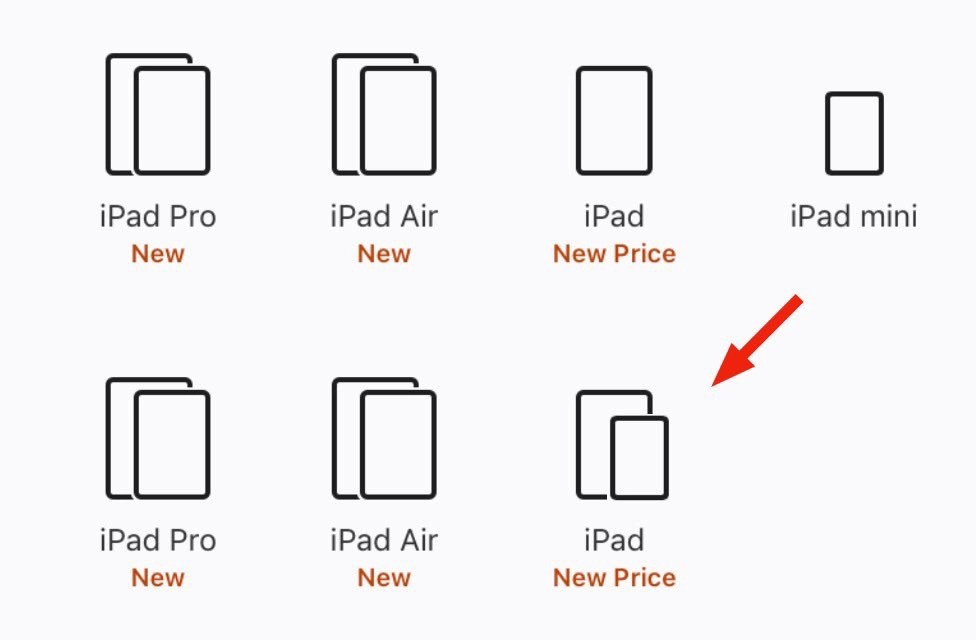With 48 individual iPad configurations available from Apple, there are more choices in the lineup than ever. When simplified, though, the iPad line is divided into four models: iPad, iPad mini, iPad Air, and iPad Pro. As Logan Spurgeon points out, however, there’s one thing Apple could do to really bring clarity to the iPad line.
iPad mini doesn’t have to be premium
Logan created a simple graphic to illustrate how Apple could “heal the ‘too many iPads’ argument” with a single move.

Repositioning the iPad mini as a smaller version of the standard iPad has appeal. Apple offers the iPad Air and iPad Pro in two sizes already.
The problem, for now at least, is that the standard iPad is positioned as a lower tier product than the iPad mini. Miniaturization can be premium—see the 12-inch Retina MacBook—but the iPad mini doesn’t have to be.
iPad mini isn’t a smaller iPad Air or iPad Pro
Others have suggested turning the iPad mini into a third size of iPad Air or iPad Pro. This lacks the balance of having three tiers with two screen sizes each.
More importantly, the iPad Air and iPad Pro both use M-series chips like the Mac line. Both the standard iPad and iPad mini use A-series chips like the iPhone.
Stage Manager on the iPad mini could be cool, but you’d need to buy the magnifying glass separately.
This isn’t happening anytime soon
Setting aside Apple’s strategy for how to best run the iPad business, I think it’s clear we won’t see this happen anytime soon, if ever.
| Base storage | Base price | Chip | Screen size | |
|---|---|---|---|---|
| iPad mini | 64GB | $499 | A15 Bionic | 8.3-inch |
| iPad | 64GB | $349 | A14 Bionic | 10.9-inch |
After reducing the 10th-gen iPad price by $100 this week, the delta between iPad and iPad mini is $1501 for now. The premium is for a smaller screen and a one-generation newer processor.
If Apple updates the iPad mini to join the landscape front-facing camera crowd, it will surely come with a processor upgrade as well. We’re up to the A17 currently, and an A18 could be out by the time Apple updates the iPad mini.
The current iPad mini was released in 2021 and used the same A15 Bionic chip as the then-new iPhone 13. Apple could easily update the iPad mini with a reoriented front-facing camera, base 128GB storage, new colors, and whatever Apple calls the A-series chip2 inside the iPhone 16.
The reality is that with the $329 9th-gen iPad discontinued and the 10th-gen iPad now priced at $349, reframing the iPad mini as a smaller standard iPad would need a price lower than Apple has taken any iPad.
Apple just doesn’t seem interested in selling iPads for any less. Instead, it uses chip generations to differentiate, and the chips are chosen to last a long time without being dated. In that sense, the iPad mini is a bit like the iPhone SE.
- While Apple doesn’t discount products, iPad mini is regularly discounted by 20% at other retailers. This drops the delta to just $50, but it’s still paying more for less screen and a little more power. ↩︎
- iPhone 15 Pro uses the A17 Pro chip and iPhone 15 uses the A16 Bionic chip. The Pro chip name suggests Apple could label the iPhone 16 chip as A18 while the iPhone 16 Pro gets A18 Pro. This would close the generational gap created a few years ago—not that non-Pro customers notice. ↩︎
Follow Zac: X, Threads, Instagram

